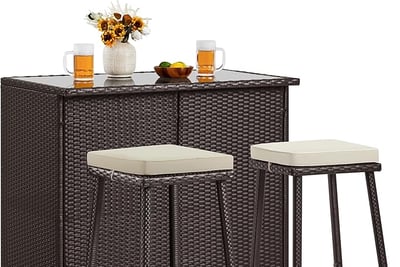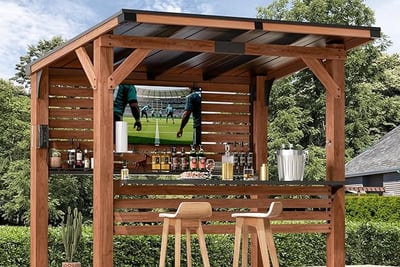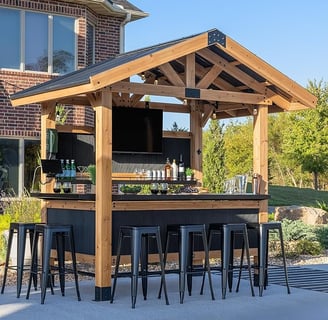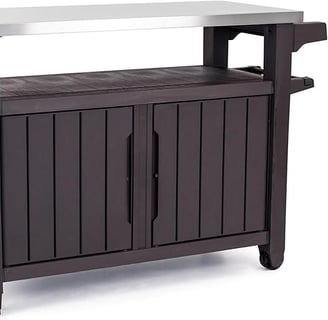How to Build a DIY Outdoor Bar for Entertaining
8 min read


Introduction to DIY Outdoor Bars
In recent years, outdoor bars have gained significant popularity among homeowners looking to enhance their outdoor entertaining spaces. These structures not only serve as functional areas for serving drinks but also create a social hub for gatherings, celebrations, and casual relaxation. As the trend of outdoor living continues to grow, the DIY outdoor bar concept emerges as a creative solution for individuals eager to transform their patios, decks, or gardens.
One of the most appealing aspects of a DIY outdoor bar is the opportunity for customization. Homeowners can design their bars according to personal preferences, allowing for unique styles, materials, and layouts that suit their specific taste and outdoor aesthetics. Whether one prefers a rustic wooden bar, a modern stainless-steel setup, or a compact foldable version, the possibilities are virtually limitless. This customization means that the outdoor bar can be tailored to fit within the contours of the space, maximizing functionality without sacrificing design.
Moreover, constructing a DIY outdoor bar can be a cost-effective alternative to purchasing pre-built options. Many ready-made outdoor bar sets can be quite expensive, and building your own allows for significant savings while enabling you to choose high-quality materials that ensure durability. By investing time and effort in creating a personalized bar, homeowners can also add value to their property, attracting potential buyers in the future.
Additionally, establishing an outdoor bar fosters an inviting atmosphere for guests, encouraging social interaction and memorable moments. It creates a designated space for mixing drinks, tasting local brews, or enjoying cocktails under the stars. As we delve deeper into the process of creating a DIY outdoor bar, we will explore various considerations, planning stages, and step-by-step instructions that will assist in bringing your vision to life.
Planning Your Outdoor Bar Design
When embarking on the project of building a DIY outdoor bar, the initial planning phase is crucial for ensuring a successful and enjoyable experience. First, consider the location of your outdoor bar. It should be situated in a space that maximizes convenience and accessibility while remaining integrated with the flow of your existing outdoor environment. Factors such as proximity to your home, access to utilities, and views of your garden or landscape can significantly influence your decision.
The size of your outdoor bar is also a fundamental aspect that requires careful thought. The dimensions should reflect the intended use of the bar; for instance, if you're envisioning it as a bustling gathering spot for entertaining guests, a larger structure with ample seating and counter space is advisable. Conversely, for a more intimate setting, a smaller, compact design might suffice. Sketching a blueprint of your outdoor bar can aid in visualizing the layout. Include measurements and proposed features to help you make informed decisions as you proceed.
Functionality is yet another key consideration. Think about what you will be utilizing the bar for – will it feature a sink, a refrigerator, or perhaps a built-in grill? These elements not only enhance the bar’s functionality but also contribute to the overall aesthetic. Additionally, you must ensure that your materials are weather-resistant. Depending on your climate, select durable options that can withstand rain, sun, and temperature variations.
Style choices should also harmonize with your home's architectural elements and landscape design. Whether you opt for a rustic wooden finish or a sleek contemporary look, the outdoor bar should feel like an extension of your living space. Lastly, consider how the bar interacts with existing outdoor features, such as seating areas, fire pits, or landscaping, to create a cohesive entertaining environment.
Gathering Essential Materials and Tools
Creating a DIY outdoor bar involves careful consideration of various materials and tools essential for a successful build. The choice of materials significantly impacts the bar's durability and aesthetics. Common options include wood, metal, and composite materials. For a rustic look, treated lumber or cedar are excellent choices due to their weather-resistant properties. If you're looking for modern aesthetics, powder-coated aluminum can provide a sleek finish and withstand outdoor conditions. Composite materials, on the other hand, offer low maintenance and high durability, making them an appealing option for many DIY enthusiasts.
In terms of construction methods, a basic framework is typically constructed using 2x4 lumber, providing a sturdy base. Alternatively, a more refined look can be achieved by utilizing reclaimed wood, which adds character and uniqueness to the bar. Whatever material is chosen, ensure that it is treated to resist moisture and decay, especially for outdoor use.
Furthermore, the right tools are crucial for constructing a DIY outdoor bar effectively. Essential hand tools include a tape measure, level, and a saw, which are fundamental in cutting and assembling the materials. For a more sophisticated approach, power tools such as a cordless drill, miter saw, and jigsaw can speed up the construction process and provide more precise cuts. Additionally, investing in a sander for smooth finishes can enhance the overall appearance of the bar.
When it comes to sourcing these materials and tools, local hardware stores often carry a wide range of options. Online retailers also provide convenience and may offer bulk purchasing discounts. Be sure to compare prices and quality before making any purchases, ensuring that the materials selected will provide longevity and satisfaction in your DIY outdoor bar project.
Step-by-Step Construction Process
Constructing a DIY outdoor bar can be a rewarding project that enhances your outdoor entertaining space. Here is a detailed, step-by-step guide to ensure that your bar is built safely and effectively.
Begin by selecting a suitable location for your bar. Ensure that the ground is level and firm to provide a stable foundation. Next, measure the dimensions of the bar you wish to create. A common height for outdoor bars is around 42 inches to accommodate standing guests comfortably, while a width of 20 inches allows for ample space for service and storage.
The first step in the construction process is the framing. Using treated lumber is advisable as it resists moisture and insects. Cut the wood according to your measurements, and assemble the frame using wood screws to ensure durability. Remember to pre-drill holes to prevent the wood from splitting. Once the frame is constructed, secure it to the ground by anchoring it with concrete footers or stakes, depending on the height of your design.
Following the frame setup, the next stage involves attaching the surface. Choose a weather-resistant material such as plywood or composite decking. Attach it securely on top of the frame with screws, ensuring that there are no sharp edges or protrusions that could cause injury. Attention to detail in this step will enhance both the safety and aesthetics of your outdoor bar.
Once the surface is established, consider adding shelves or storage compartments for added functionality. Use the same treated lumber, and design these elements to fit the dimensions of your bar. Position them at a comfortable height and ensure they are securely fastened to the frame.
Throughout the construction process, prioritize safety. Wear appropriate protective gear, including gloves and goggles, to protect against injury. Ensure that all tools are used per their instructions and stored safely when not in use. By following this step-by-step guide and maintaining safety precautions, you can successfully build an outdoor bar that enhances your entertaining experience.
Personalizing Your Outdoor Bar
Creating a unique and inviting atmosphere for your DIY outdoor bar begins with personal touches that reflect your style. One of the most impactful ways to achieve this is through the use of paint or stain on wooden surfaces. Choosing a color that contrasts with your landscaping can enhance its visibility, while a stain can highlight the natural grain of the wood, providing a rustic or polished look based on your preference. Additionally, consider using weather-resistant finishes to ensure longevity and maintain aesthetic appeal over time.
Lighting also plays a significant role in personalizing your outdoor bar. Incorporating unique lighting options such as string lights, lanterns, or even colored LED lights can set the mood for evening gatherings. Creative lighting solutions not only enhance visibility but also add a touch of charm and ambiance, making the outdoor bar a more inviting space. Experimenting with different fixtures can yield a variety of effects, which can align with specific themes, such as tropical, vintage, or modern.
The selection of bar stools is another opportunity to inject personality into your outdoor entertainment area. Opt for options that complement your chosen theme. For instance, wicker stools can evoke a laid-back beach vibe, while metal or industrial designs can lend an urban feel. Additionally, comfort should not be sacrificed; consider cushions or padded seats for enhanced enjoyment during long social sessions.
Finally, adding decorative elements like potted plants, artwork, or even personalized signage can further enhance the individuality of your outdoor bar. Incorporating greenery can soften the look and create a connection to nature, while art pieces or themed decorations can reflect your interests and personality. By combining these elements, you not only create a functional space but also an inviting environment that resonates with your personal aesthetic.
Essential Bar Accessories and Supplies
Creating a functional DIY outdoor bar requires careful planning and attention to detail, particularly when it comes to selecting essential accessories and supplies. Investing in high-quality drinkware is crucial; this includes durable glasses that cater to different beverages such as cocktails, beer, and wine. Materials like tempered glass or acrylic are often preferred for outdoor use, as they can withstand temperature changes and are less likely to shatter.
In addition to drinkware, having the right bar tools is vital for mixing and serving drinks efficiently. A basic set should include a cocktail shaker, strainer, jigger, and bar spoon. These tools enable bartenders to prepare drinks accurately and with style. Bottle openers and corkscrews are also necessary for accessing beer and wine, making them essential accessories for any outdoor bar setup.
Storage solutions are equally important, as they help maintain organization and keep everything readily accessible. Consider incorporating shelves or cabinets that can store spirits, mixers, and garnishes. An ice bucket or cooler is essential for keeping drinks refreshingly cold, while mason jars or decorative bowls can serve as charming containers for mixers and snacks.
Stocking the bar with a variety of beverages is vital for catering to diverse tastes and ensuring every gathering is a success. Include a selection of base spirits such as vodka, rum, gin, and whiskey, alongside liqueurs that can be used in various cocktails. Additionally, incorporating a mix of non-alcoholic options such as soda, tonic water, and fruit juices is essential for accommodating guests who prefer lighter beverages or those who do not drink alcohol. By thoughtfully curating an inventory that spans a range of options, your outdoor bar will be prepared for virtually any occasion.
Maintenance and Care for Your Outdoor Bar
Maintaining your outdoor bar is crucial to ensuring its longevity and functionality. As with any structure exposed to the elements, regular care will help prevent damage caused by weather, pests, and wear. It is essential to adopt a proactive approach to upkeep, focusing on cleaning, protection, and seasonal preparations for the outdoor bar.
Cleaning should be done frequently to remove dirt, debris, and stains that accumulate over time. A simple solution of mild soap and water can effectively clean surfaces without causing damage. Use a soft cloth or sponge to prevent scratching and misuse of harsh chemicals that might harm the materials of your bar. Additionally, it is advisable to routinely rinse the entire bar to wash away residual soap or cleaning agents.
Protecting your outdoor bar from weather damage is vital. When it comes to rainy seasons, investing in a high-quality waterproof cover can shield your bar from moisture damage, preventing rot or rust in metal components. For wooden bars, applying a sealant or outdoor varnish can enhance water resistance and stave off common mold or decay issues. Be sure to check the sealant's integrity periodically, reapplying it if any wear is evident.
Seasonal preparations are equally important in maintaining the appearance and functionality of your outdoor bar. Before winter, clearing the bar of any items, such as glassware or decorations, and properly covering it can safeguard against harsh conditions. In the spring, perform a thorough inspection for any signs of wear or damage caused by cold weather. Addressing any issues early will ensure the bar remains a centerpiece for entertainment.
Regular upkeep tasks, such as checking for loose screws, tightening joints, and replacing any damaged components, should be part of your maintenance routine. By attending to these tasks, you can efficiently manage the lifespan of your outdoor bar, keeping it in great shape for years to come.











